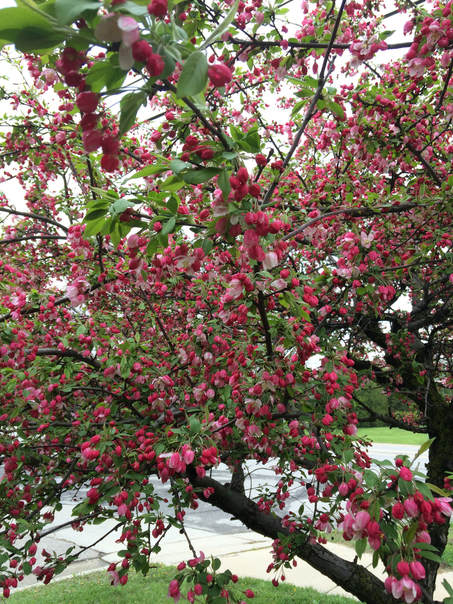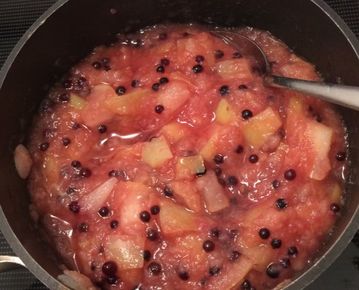Apple / Crabapple (Malus spp.)
The humble and wonderful apple has long been a friend of mine. They’re one of the few foods I never tire of. Apples and crabapples both are abundant here in Michigan, and every autumn brings bushels of tasty, locally-grown apples to be eaten fresh, cooked into sauce, pies, crisps, and cobblers. There are so many great things to make with apples!
One of my favorite things to find while foraging and wildcrafting is wild apples. The ones I like best are sweet and tangy, with a crisp acidic bite that gets the digestive juices flowing. A good place to start looking for wild apples are old overgrown farm fields, the ones that have been lying fallow for years and have turned into fields and hollows of waving grasses, small trees, and shrubs. In years past, it was common to have fruit trees near the house and kitchen garden, providing easy access to tasty, nutrient-dense fruits for the family and farm animals alike. Humans are not the only ones who enjoy apple trees – domestic animals like horses, pigs, and goats enjoy and benefit from apple trees. All sorts of wildlife, from small birds, mammals, and snakes up large animals like elk and bear, rely on apples and apple trees for sustenance and shelter. Bees love apple trees too.
Apple or Crabapple?
Apples and Crabapples share many of the same characteristics in bark, leaf, fruit, growth pattern and distribution. Both share the genus Malus. But how do you tell what’s an apple and what’s a crabapple? Size. That’s about it. Crabapple fruit is under 2” in diameter, while apples are larger than 2”. As size has little effect on the medicinal use of Apple/Crabapple, from here on out if I mention one, I mean both.
One of my favorite things to find while foraging and wildcrafting is wild apples. The ones I like best are sweet and tangy, with a crisp acidic bite that gets the digestive juices flowing. A good place to start looking for wild apples are old overgrown farm fields, the ones that have been lying fallow for years and have turned into fields and hollows of waving grasses, small trees, and shrubs. In years past, it was common to have fruit trees near the house and kitchen garden, providing easy access to tasty, nutrient-dense fruits for the family and farm animals alike. Humans are not the only ones who enjoy apple trees – domestic animals like horses, pigs, and goats enjoy and benefit from apple trees. All sorts of wildlife, from small birds, mammals, and snakes up large animals like elk and bear, rely on apples and apple trees for sustenance and shelter. Bees love apple trees too.
Apple or Crabapple?
Apples and Crabapples share many of the same characteristics in bark, leaf, fruit, growth pattern and distribution. Both share the genus Malus. But how do you tell what’s an apple and what’s a crabapple? Size. That’s about it. Crabapple fruit is under 2” in diameter, while apples are larger than 2”. As size has little effect on the medicinal use of Apple/Crabapple, from here on out if I mention one, I mean both.
Growth Pattern and Botanical Identification
There are many species and varieties within the Malus genus. They all tend to have the same basic appearance – stout, somewhat bushy-looking trees between 10-25 feet tall with scaly gray-brown bark, dark green oval leaves, and short, stout branches. Leaves are alternate, broad, slightly toothed, typically oval and pointed. White or light pink, sweet-smelling, 5-petaled, symmetrical flowers bloom in springtime, giving way to fruit in the fall. Five seeds surround the center of the fruit in a star-shaped pattern (cut the fruit on its horizontal axis to see the star). Apple trees are typically propagated by grafting, and will grow in many conditions but prefer full sun and drier soil.
These days, most apple and crabapple trees that you will see are planted as ornamentals for their lovely blossoms, or as fruit-bearing trees. Apples and crabapples can vary widely in size and taste. The best way to find out is to taste them before you pick. Windfall apples tend to be sweetest and most ripe (and easiest to gather), if you can get to them before the wildlife does!
Energetics & Taste:
Cooling, bitter (bark, leaves)
Cooling, sweet, sour, bitter (fruit)
Actions:
Anti-inflammatory, astringent, antiseptic, diuretic (juice/cider)
Preparations:
Food, Tea, Tincture, Elixir, Fermented into apple cider vinegar
Herbal Uses:
Apple is a great example of using food as medicine. People have been using apples to “keep the doctor away” for ages! Apples most notably contain pectin, malic acid, tartaric acid, vitamins, minerals, and fiber. I like to eat apples raw or cook them into tasty food. Fresh apple peels can be used to make apple butter or apple cider vinegar, while dried peels are lovely in winter teas. The leaves and bark can be used for tea or made into tincture. Botanically, Apple is part of the Rosaceae family, and therefore a cooling astringent.
The Apple tree has been used across the world, in multiple healing traditions. Ayurveda, Native American healers, Traditional Chinese Medicine, Traditional Western herbalism and folk medicine all utilize apple for its cooling, astringent properties. Primary uses for Apple bark, leaf, and fruit (both historical and current) are:
- digestive troubles like heartburn and hyperacidity, indigestion, diarrhea, and constipation
- sore throats and mouth troubles
- fevers
- lymphatic and spleen tonic, to strengthen spleen yin
- arthritis and gout
- weak, inflamed, and rheumatic eyes
Apple cider and applesauce are two great options for consuming tinctures, powders, and other herbal remedies, especially in the case of reluctant children, elders, or anyone who likes apples.
It is worth mentioning that apple seeds, bark, and leaves all contain levels of hydrocyanic acid, which in large quantities can be toxic. Is most concentrated in the seeds, less so in the bark and leaves. Apple seeds are not used in herbal medicine that I’ve ever heard (and I wouldn’t advise eating more of them than you would in the eating of one entire apple), but apple bark and leaf are used. Many herbalists I know use smaller doses of apple bark/leaf preparations, as a precaution. More information can be found in jim mcdonald’s Malus monograph – link here.
Apple is a great example of using food as medicine. People have been using apples to “keep the doctor away” for ages! Apples most notably contain pectin, malic acid, tartaric acid, vitamins, minerals, and fiber. I like to eat apples raw or cook them into tasty food. Fresh apple peels can be used to make apple butter or apple cider vinegar, while dried peels are lovely in winter teas. The leaves and bark can be used for tea or made into tincture. Botanically, Apple is part of the Rosaceae family, and therefore a cooling astringent.
The Apple tree has been used across the world, in multiple healing traditions. Ayurveda, Native American healers, Traditional Chinese Medicine, Traditional Western herbalism and folk medicine all utilize apple for its cooling, astringent properties. Primary uses for Apple bark, leaf, and fruit (both historical and current) are:
- digestive troubles like heartburn and hyperacidity, indigestion, diarrhea, and constipation
- sore throats and mouth troubles
- fevers
- lymphatic and spleen tonic, to strengthen spleen yin
- arthritis and gout
- weak, inflamed, and rheumatic eyes
Apple cider and applesauce are two great options for consuming tinctures, powders, and other herbal remedies, especially in the case of reluctant children, elders, or anyone who likes apples.
It is worth mentioning that apple seeds, bark, and leaves all contain levels of hydrocyanic acid, which in large quantities can be toxic. Is most concentrated in the seeds, less so in the bark and leaves. Apple seeds are not used in herbal medicine that I’ve ever heard (and I wouldn’t advise eating more of them than you would in the eating of one entire apple), but apple bark and leaf are used. Many herbalists I know use smaller doses of apple bark/leaf preparations, as a precaution. More information can be found in jim mcdonald’s Malus monograph – link here.
Recipe
Here’s my recipe for simple tasty Stovetop Apples. These can be a side dish or a dessert, are super easy to make, and can be made for one person or a hundred. Recipe below is for one person.
Here’s my recipe for simple tasty Stovetop Apples. These can be a side dish or a dessert, are super easy to make, and can be made for one person or a hundred. Recipe below is for one person.
- Wash, core, and cut up a medium-sized apple into a small saucepan. Add a teensy bit of water, ¼ to ½ inch deep. Cook on low heat, stirring occasionally, until the apple softens to your liking.
- At some point in the cooking process, add a shake of cinnamon and a small handful of Saskatoon berries, blueberries, black currants, or similar. Some chopped nuts would taste good too.
- Once the apple has softened to your liking, drizzle with hickory syrup and remove from heat. Time to eat!
This is a very free-form, improvisational recipe that I just made up as I went along. It turned out well, so I filed it away in my mental card catalog for future use. Feel free to substitute honey, maple syrup, or similar for the hickory syrup. Customize by adding other fruits or spices to your taste!

